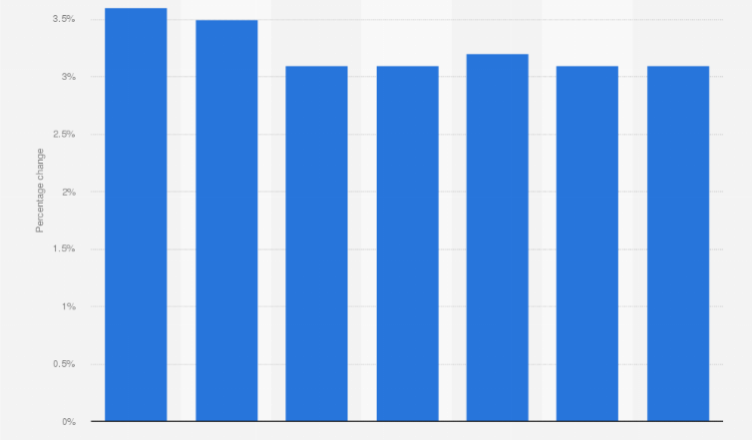Inflation is more than a background economic figure—it’s a market mover, a portfolio shaper, and a key indicator that seasoned traders monitor closely. For many, the Consumer Price Index (CPI) gets all the attention. However, the often-overlooked Retail Price Index (RPI) still plays a crucial role, particularly for traders with international exposure.
In the UAE, where economic activity is intertwined with global markets, inflation metrics like RPI can offer traders valuable signals that aren’t always captured in local data.
Understanding the RPI: A Legacy with Impact
The Retail Price Index (RPI) is one of the oldest measures of inflation. First introduced in the UK in 1947, it was initially designed to track changes in the cost of living, particularly post-war economic recovery. Unlike CPI, which was later developed and is now more commonly used in monetary policy, RPI includes certain costs that CPI does not, most notably mortgage interest payments and council taxes.
RPI index calculates inflation by tracking the average change in prices of a specific basket of goods and services. However, the way it calculates these price changes differs from CPI. RPI uses an arithmetic mean, while CPI employs a geometric mean, making CPI typically lower in value and more stable.
Despite being somewhat deprecated in official use, RPI is far from obsolete. It remains deeply embedded in the financial system, particularly in older contracts and long-term investment products.
RPI’s Global Relevance and Why UAE Traders Should Care
You might wonder why a UK-centric inflation index matters for a trader sitting in Dubai or Abu Dhabi. The answer lies in how financial instruments are structured and how global capital flows interact.
A large number of UK-issued bonds are still indexed to RPI. These “index-linked gilts” adjust their payouts based on RPI movements. For institutional investors in the UAE who hold international bond portfolios or ETFs containing these securities, RPI fluctuations can directly impact returns.
Furthermore, multinational corporations often have pension liabilities, wage agreements, or rental contracts tied to RPI. If you’re trading equities of such companies, particularly in sectors like utilities or real estate, RPI trends can influence earnings expectations and stock prices.
Currency traders should also take note. Inflation surprises—especially when RPI deviates sharply from CPI—can influence interest rate expectations in the UK. This, in turn, impacts currency pairs like GBP/AED. An unexpected uptick in RPI could stoke fears of future rate hikes by the Bank of England, potentially boosting the pound and creating short-term forex opportunities.
Inflation Metrics in the UAE: The Local Context
In the UAE, inflation is primarily measured through CPI. It reflects changes in prices for goods and services across major categories like food, transportation, housing, and healthcare. Given the UAE’s heavy reliance on imports and a relatively unique rental-driven housing market, the CPI here is tailored to local dynamics.
However, it doesn’t always tell the whole story, especially for traders with exposure beyond the UAE. Unlike RPI, UAE’s CPI does not include mortgage interest rates, and housing costs are weighted differently. In addition, the local CPI doesn’t capture the ripple effects of global inflation as immediately or completely as indices like RPI or US CPI might.
This creates blind spots. For example, if RPI in the UK is climbing due to housing and energy cost increases, that could eventually translate into higher costs for imported goods or affect property investments held abroad—yet this wouldn’t be visible in the UAE’s CPI until much later, if at all.
By supplementing their view with metrics like RPI, UAE traders can build a more comprehensive understanding of global inflation pressures and how they might feed into asset prices over time.
Trading Strategies Informed by RPI Insights
Integrating RPI into trading strategies offers a range of opportunities across asset classes.
- Fixed Income: Traders involved in bond markets should consider the implications of RPI on inflation-linked gilts and other securities. Rising RPI generally boosts the payouts on these instruments, making them more attractive compared to nominal bonds. This can drive demand, influencing bond prices and yields—critical data for UAE traders managing global bond portfolios.
- Commodities: Inflation is a key driver of commodity prices, particularly for precious metals like gold. When RPI shows signs of climbing inflation that’s not yet reflected in CPI, it can act as an early signal to buy into real assets. Commodities are often seen as a hedge against inflation, so being ahead of the curve here can offer traders a meaningful edge.
- Forex: In foreign exchange markets, inflation expectations drive interest rate policy. A surprise rise in RPI may not immediately prompt central bank action, but it does influence sentiment. If RPI rises faster than CPI, markets may interpret this as underappreciated inflation risk, potentially strengthening GBP and impacting GBP/AED and other relevant crosses.
Conclusion
Inflation is never just a domestic story, and for UAE traders, understanding the global inflation narrative is essential. While the RPI may seem like an outdated metric, it remains a powerful tool for identifying shifts in financial markets, particularly in the UK and among assets linked to legacy contracts.
By incorporating RPI into their toolkit, UAE-based traders can anticipate market movements more effectively, manage cross-border risks, and spot opportunities that others might miss. In a world where every edge matters, overlooking the RPI could mean leaving money on the table.

